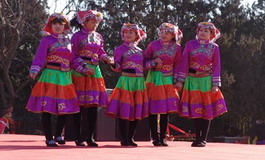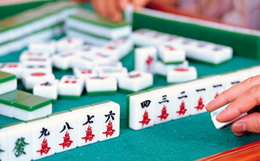
Getting familiar with the dance of the brush
This led me to organize an artistic exhibition about the boundaries of Chinese calligraphy. I wanted to show that calligraphy was not an art that barely consisted in reproducing pieces written during the Tang dynasty, that it belongs to art’s big family and has surprising acquaintances with different forms of expression. I therefore looked for innovative calligraphers and had the luck to find Wong Wa, who manages to mix calligraphy and sculpture. His sculptures contain Chinese characters, usually in the seal script. What impressed me most about his work was the way he keeps balance between innovation and tradition, both in the pieces of art he makes and in his way of working, practicing calligraphy in different styles daily while never hesitating to do something completely new when he has an idea. Andre Kneib, a French calligrapher who had exhibitions in China before and who brought innovation by using color in his calligraphy work, also agreed to be part of the exhibition. But both of them warned me: it is not easy to find a venue and an audience for a calligraphy exhibition in France. Wong Wa was particularly pessimistic. But in the end, I managed to convince the owner of a gallery in the city center of Paris to hold the exhibition. I was therefore incredibly happy…
At this critical moment it was time for me to fly to China. I was leaving Paris for China, thereby missing the calligraphy exhibition I had organized. I missed it because I was going to the land of calligraphy – the irony was not lost on me.
The funniest thing is that this paradox lasted. I got busy in China… When I found some calligraphy classes at the university, I was not satisfied. There were too many students so the teacher could not provide individual guidance and had to focus on people who were complete beginners… It made me give up and I only practiced a bit of calligraphy alone and when I had time, which meant only in rare occasions. Truth was, I was rusting. But as I did not make many arty friends in Beijing, I was constantly involved in a variety of things that put me away from calligraphy.
During one year and a half, I almost did not practice and did not make any progress. But at some point, because I was feeling pressure from studies and work, I realized I should go back to calligraphy, at least to relax a little bit during those moments when I can focus on the moves of the brush in a quiet painting room. I found a small school near the place where I live and had the second “calligraphy trial class” of my life. And this time, the virus was back for good, with a very good and kind teacher who could provide me with the explanations I needed to make progress and broaden my horizons. Now, I have started studying Zhao Mengfu’s style… I mainly practice his kaishu, but I am also trying xingshu… And every minute spent with a brush in my hand is a delight. Nietzsche used to say: “We should consider every day lost on which we have not danced at least once”. I would add: “I should consider everyday lost on which my brush has not danced at least once”.
By Laurent Hou
 |
 |


